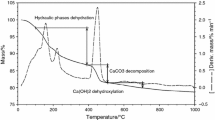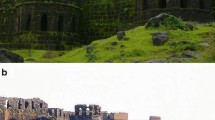Abstract
The binders of historic mortars composed of small grain sized silica (SiO2) and carbonated lime (CaCO3) are considered as the main part that give hydraulic character and high strength to the mortar. In this study, FTIR, SEM–EDS, LIBS and XRD spectroscopy were used to find out the weight ratios of CaCO3 to SiO2 in the binders of historic lime mortars. For this purpose, a series of pure calcium carbonate and silica mixture were prepared in ten combinations in varying ratios from 0.5 to 5. Calibration curve was prepared for each analysis by plotting the peak area or intensity ratios of CaCO3 to SiO2 versus the weight ratios of CaCO3 to SiO2. A good linear correlation coefficient was obtained for each analysis respectively. The analyses were then tested on the binder of the Roman mortar samples. The results indicated that FTIR, SEM–EDS and LIBS spectroscopy are convenient tools to determine the weight ratios of CaCO3 to SiO2 in the binders of mortars. But XRD spectroscopy is not convenient for quantitative analysis of binders due to the presence of varied amounts of amorphous or poor crystalline silica in their compositions.











Similar content being viewed by others
References
Adam JP (2005) Roman building materials and techniques. Routledge, London
Aslan Özkaya Ö, Böke H (2009) Properties of Roman bricks and mortars used in Serapis Temple in the city of Pergamon. Mater Charact 60:995–1000. doi:10.1016/j.matchar.2009.04.003
Bakolas A, Biscontin G, Moropoulou A, Zendri E (1995) Characterization of the lumps in the mortars of historic masonry. Thermochim Acta 269–270:809–816. doi:10.1016/0040-6031(95)02573-1
Barba L, Blancas J, Manzanilla LR, Ortiz A, Barca D, Crisci GM, Miriello D, Pecci A (2009) Provenance of the limestone used in Teotihuacan (Mexico): a methodological approach. Archaeometry 51:525–545. doi:10.1111/j.1475-4754.2008.00430.x
Böke H, Akkurt S, Özdemir S, Göktürk EH, Caner Saltik EN (2004) Quantification of CaCO3–CaSO3–0.5H2O–CaSO4–2H2O mixtures by FTIR analysis and its ANN model. Mater Lett 58:723–726. doi:10.1016/j.matlet.2003.07.008
Böke H, Akkurt S, İpekoğlu B, Uğurlu E (2006) Characteristics of brick used as aggregate in historic brick-lime mortars and plasters. Cem Concr Res 36:1115–1122. doi:10.1016/j.cemconres.2006.03.011
Cabrera J, Rojas MF (2001) Mechanism of hydration of the metakaolin–lime–water system. Cem Concr Res 31:177–182
Degryse P, Elsen J, Waelkens M (2002) Study of ancient mortars from Sagalassos (Turkey) in view of their conservation. Cem Concr Res 32:1457–1463
Eckel EC (1928) Cements limes and plasters their materials, manufacture and properties. Wiley, New York
Elsen J (2006) Microscopy of historic mortars—a review. Cem Concr Res 36:1416–1424. doi:10.1016/j.cemconres.2005.12.006
Giakoumaki A, Melessanaki K, Anglos D (2007) Laser-induced breakdown spectroscopy (LIBS) in archaeological science—applications and prospects. Anal Bioanal Chem 387:749–760. doi:10.1007/s00216-006-0908-1
Goldstein J, Newbury DE, Joy DC, Lyman CE, Echlin P, Lifshin E, Sawyer L, Michal JR (2003) Scanning electron microscopy and X-ray microanalysis, 3rd edn. Springer, New York
He C, Osbæck B, Makovicky E (1995) Pozzolanic reactions of six principal clay minerals: activation, reactivity assessments and technological effects. Cem Concr Res 25(8):1691–1702. doi:10.1016/0008-8846(95)00165-4
Jackson MD, Logan JM, Scheetz BE, Deocampo DM, Cawood CG, Marra F, Vitti M, Ungaro L (2009) Assessment of material characteristics of ancient concretes, Grand Aula, Markets of Trajan, Rome. J Archaeol Sci 36:2481–2492. doi:10.1016/j.jas.2009.07.011
Lea FM (1940) Investigations on pozzolanas. Build Res, Tech Paper 27:1–63
Massazza F, Pezzuoli M (1981) Some teaching of a Roman concrete. In: Proceedings of the ICCROM symposium “Mortars, cements and grouts used in the conservation of historic buildings”, Rome, pp 219–248
Middendorf B, Hughes JJ, Callebaut K, Baronio G, Papayianni I (2005) Investigative methods for the characterisation of historic mortars—part 2: chemical characterisation. Mater Struct 38:771–780. doi:10.1617/14282
Middendorf B, Hughes JJ, Callebaut K, Baronio G, Papayianni I (2005) Investigative methods for the characterisation of historic mortars—part 1: mineralogical characterisation. Mater Struct 38:761–769. doi:10.1617/14281
Miriello D, Barca D, Bloise A, Ciarallo A, Crisci GM, De Rose T, Gattusco C, Gazineo F, La Russa MF (2010) Characterisation of archaeological mortars from Pompeii (Campania, Italy) and identification of construction phases by compositional data analysis. J Archaeol Sci 37:2207–2223. doi:10.1016/j.jas.2010.03.019
Miriello D, Bloise A, Crisci GM, Apollaro C, La Marca A (2011) Characterisation of archaeological mortars and plasters from Kyme (Turkey). J Archaeol Sci 38:794–804. doi:10.1016/j.jas.2010.11.002
Moropoulou A, Bakolas A, Aggelakopoulou E (2004) Evaluation of pozzolanic activity of natural and artificial pozzolans by thermal analysis. Thermochim Acta 420:135–140. doi:10.1016/j.tca.2003.11.059
Perkins JBW (1981) Roman imperial architecture. Yale University Press, New Haven
Radziemski LJ, Cremers DA (1989) Laser induced plasmas and applications. Marcel Dekker, New York
Reig FB, Adelantado JVG, Moreno MCMM (2002) FTIR quantitative analysis of calcium carbonate (calcite) and silica (quartz) mixtures using the constant ratio method. Application to geological samples. Talanta 58:811–821
Sánchez-Moral S, Luque L, Cañaveras JC, Soler V, Garcia-Guinea J, Aparicio A (2005) Lime pozzolana mortars in Roman catacombs: composition, structures and restoration. Cem Concr Res 35(8):1555–1565. doi:10.1016/j.cemconres.2004.08.009
Uğurlu E, Böke H (2009) The use of brick-lime plasters and their relevance to climatic conditions of historic bath buildings. Constr Build Mater 23:2442–2450. doi:10.1016/j.conbuildmat.2008.10.005
Acknowledgments
The authors thank the researchers of the Centre for Materials Research at the İzmir Institute of Technology for SEM-EDS and XRD analyses during the experimental stage of this study.
Author information
Authors and Affiliations
Corresponding author
Rights and permissions
About this article
Cite this article
Sağın, E.U., Böke, H., Aras, N. et al. Determination of CaCO3 and SiO2 content in the binders of historic lime mortars. Mater Struct 45, 841–849 (2012). https://doi.org/10.1617/s11527-011-9802-1
Received:
Accepted:
Published:
Issue Date:
DOI: https://doi.org/10.1617/s11527-011-9802-1




